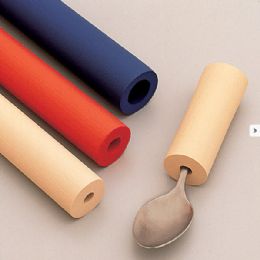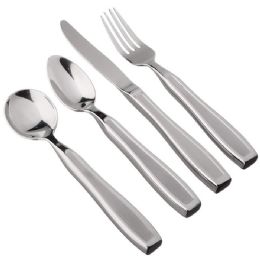














Choosing the Right Adaptive Eating Utensils and Accessories
Eating utensils, cups, plates and bowls for special needs people can all help to make eating a pleasurable pastime again. This adaptive eating and drinking equipment makes both food preparation and dining easier for individuals with cerebral palsy, Parkinson’s, arthritis and many other disabilities and physical challenges. Picking up utensils requires fine motor dexterity, an impairment that tends to worsen as we age, or that can be caused by many kinds of physical motor and sensory disabilities. Adaptive eating equipment has been specifically designed to help people who experience these difficulties to continue to feed themselves, enhancing independence and self-esteem. Ask your health care provider which adaptive equipment will work best for you.
Adaptive Drinking Cups
Some individuals have a hard time drinking from standard cups for several reasons. They may not be able to grasp the handles effectively, or may not even be able to tilt their heads back in the usual manner. Adaptive drinking devices include covered cups with straws, cups that screw down and are held firmly in place on the table or wheelchair lap-table, or other innovative designs that help individuals to drink independently.
Weighted and Built-Up Eating Utensils and Flatware
Ideal for individuals with hand tremors, weighted or built-up utensils and flatware may help reduce these tremors, allowing for more control while eating. The heavier weight helps to stabilize a tremulous and shaking hand, giving needed proprioceptive feedback for these sensory issues. The larger size is also easier to grip, which is especially helpful for people with arthritis in their hands, one of the top causes of disability in the world. Arthritis and other health issues can cause diminished grip strength, along with severe overall weakness and/or stiffness, but adaptive utensils with built-up handles can help make dining a much more enjoyable experience for everyone with these challenges.
Bendable Adaptive Utensils
For those who experience a minimal range of motion with their hands, bent or bendable utensils make it easier to deliver food into the mouth without making a mess. Some of these devices come already bent, while other forks and spoons will bend as needed when you use them.
One-Handed Adaptive Eating Equipment
Although individuals who have only one hand, or who can only use one hand, generally get very good at adapting to doing a lot of daily living activities one-handed, specially designed utensils and accessories can be very helpful at creating a much more pleasant dining experience for one-handed people of all ages. Bendable or customizable handles on utensils can be angled to the right or left, making it easier to insert the utensil into the mouth, while using one hand for dining. Specially designed handle shapes aid in reducing dining frustration for one-handed people, while knorks, a combination of a knife and fork, offer multiple functions in one utensil.
Rocker knives feature a specially curved blade that allows food to be cut using a rocking motion, rather than the two-handed knife and fork slicing method. While some rocker knife devices highlight smoother safety blades for simple dining purposes, others can be very sharp and should be used with caution, adaptive or not. Some designs highlight a 90-degree angle between the blade and handle, be sure to check out the varying designs available in order to suit your own specific requirements.
Rehabmart is pleased to offer a wonderfully diverse selection of superior quality adaptive eating utensils and accessories from renowned and innovative manufacturers that include ADL Essentials, Grip Solutions, Enabling Devices, Maddak, Sammons Preston, North Coast and Snug Seat.
Hulet Smith, OT
Rehabmart Co-Founder & CEO